






Advertise! Now Reaching 30,000+ Inspectors Nationwide!

From the Editor Readers Respond
4 4
Marketing and Sales Above All Else
6
byIsaac
Peck, PublisherSupercharging Your Home Inspections
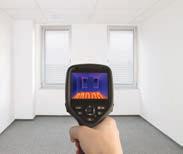
10
by Carla Heatherly, HomeGaugeAttic Defects and Goofs: The Science Behind Your Inspection
16
by Tom Feiza, Mr. Fix-It, Inc.Remote Working Conditions Can Increase Home Radon Exposure

20
by Zan Jones, RadonovaFlashing Case Study: When Dissimilar Materials Meet

24
by Greg Johns, WIN Home Inspection

Against All Odds: Interview with Harmony Brown
28
by Kendra Budd, EditorAsk the Engineer: Do Basements Need a Second Exit?
32
by Charles Turner, P.E.Home Inspections vs. Code Inspections by Reuben
Saltzman, Structure TechProfessional Marketplace
40
Mission
Working RE Home Inspector magazine is published tri-annually to help home inspectors build their businesses, reduce their liability and risk, and stay informed on important technology and industry issues.
Published by OREP
Working RE is published by OREP, a leading provider of home inspector insurance nationwide. OREP has a low cost, broad coverage E&O and General Liability policy that includes coverage for radon, infrared, termite, pest/rodent, lead paint, mold, drone, and more. Visit OREP.org/inspectors for more information or to get a quote today!
OREP Insurance Services, LLC. Calif. Lic. #0K99465
36
Publisher Isaac Peck: isaac@orep.org
Marketing & Design Manager
Ariane Herwig: ariane@orep.org
Editor Kendra Budd: kendra@orep.org
Graphic Design Associate Maria Cornelia: mj@orep.org
Working RE Home Inspector is published tri-annually and mailed to home inspectors nationwide. The ads and specific mentions of any proprietary products contained within are a service to readers and do not imply endorsement by Working RE. No claims, representations or guarantees are made or implied by their publication. The contents of this publication may not be reproduced either whole or in part without written consent.

 By Kendra Budd, Editor
By Kendra Budd, Editor

Great information, but just as with any business, good legal counsel is imperative for not only start up business, but also running a seasoned business. Reviewing agreements, addendums, local, state and federal registrations are a must and worth every penny. Insurance is another important piece of a business puzzle. There are numerous pages of descriptive coverage for a home inspector, and a review of the documents with your personal agent is necessary.
Dave P. | AdvantageNCHome inspection is no easy profession to get started in. It is one that is not advertised heavily, seldom talked about in college, and very rarely included on the career tests you have to take in high school. So, it’s no wonder that many don’t even know about home inspectors until they need to buy a house, or get into another facet of the real estate industry. Then, once you learn about home inspecting, it can be intimidating to get started—especially if you don’t feel yourself reflected in the industry. That’s why tenacity and persistence are the most important skillset for any home inspector to have.
I’ve been particularly inspired by the story of Harmony Brown of GreenWorks Inspections and Engineering—an inspector that has defied the odds against her. Brown has had to work twice as hard as most in the home inspection industry as a Black woman. However, what I find most empowering about her story is she pushed against the barriers placed in her path with no complaints—and continues to do so. She just brushes it off her shoulder and continues to work hard.
I know many home inspectors feel disgruntled and at a loss— especially with the current slowdown. It’s easy to give up, but great companies and successful home inspectors fight through the barriers and continue forward. Motivation is a home inspector’s greatest strength. As Brown says in her interview, it’s all about attitude, such as understanding if you “have to do more to be the best…that’s only going to make [you] the best.” Sometimes, we have to work both smarter and harder to be great at what we do. (Read Against All Odds: Interview with Harmony Brown on pg. 28).
Now, with her can-do attitude, Brown, over the past 13 years has managed to create one of the most successful home inspection companies in the United States, with over 100 inspectors under her belt, completing over 1,500 inspections a month. Those are numbers every inspector should be striving for.
Sometimes, the temptation to throw in the towel is strong or maybe to just work at half the effort you once did—but that doesn’t bring in business. The key is having the right mindset and staying motivated, so whether you’re just starting out or have been doing this for over thirty years, remember: there will be bumps in the road, but the journey to your career success will well have been worth it. WRE
I have an inspector telling my buyer that I need a roof replacement and my roof is in perfect condition, no leak, only a few broken or loose tiles. This has caused me to lose my buyer. Not only that, he left the water valve to my washer on after his inspection and has caused the hoses to burst due to pressure. That valve was always in the off position. Only when the washer is operating, is it on. Marie S.
The Top 20 Home Inspection Mistakes I’ve Made I strongly [disagree] with the GFCI test button, I’ve checked many that the test button works but then fails the check with my external testing device. —Ray H.
This information should be a selling feature for inspectors that carry E&O insurance protection. Many do not carry and this protection separates professionals from the trades. Cheers! Dave
P. | AdvantageNC
Mark Cuban, entrepreneur, investor and owner of the Dallas Mavericks, is fond of saying: “Sales cure all.”
While many home inspectors approach the inspection profession with a focus on the technical side and are quick to point out that one needs quality education, thorough training, an experienced mentor, and effective tools, the foundational nature of sales and marketing for a home inspection business is a reality that inspectors know all too well.
Working RE’s research reveals that over 10,000 would-be home inspectors purchase pre-licensing education or training, either live or in-person, every single year. The promise of being one’s own boss, making over six figures (say the training companies!), and building a business is attractive to many. From those 10,000 souls, roughly 50% actually complete the training, and a fraction of those graduating students actually “make a go of it” and become a practicing home inspector.
While exact numbers about those newly minted home inspectors are hard to come by, an estimated 60 percent of inspectors fail in their first year, and a rumored 90 percent fail in their first five years.

Talk about a culling of the herd! And what is the biggest reason home inspectors throw in the towel?
You guessed it. Not enough marketing. Not enough sales. (In that order, too.)
So, what exactly does it take for a home inspector to market their business and sell their services effectively?
Home Inspector Versus Marketer
Are you in the marketing business or the home inspection business? The answer is both, right?
Mike Crow, founder of Coach Blueprint and the “Father of Home Inspector Marketing,” says that the average home inspector doesn’t realize he or she isn’t in the home inspection business, they are in the “marketing of a home inspection” business.
“Most home inspectors think they’re in a technical business. They’re not. They are in a marketing business. That is true of all businesses, but it is especially true of a home inspection business. Providing a good, solid home inspection is absolutely necessary—but it is the baseline. To be successful as a home inspector long-term, whether you want to be a solopreneur or you want to build a multi-inspector firm, you have to understand how vital marketing is. Many truly great and knowledgeable inspectors don’t have enough business or simply go out of business because they don’t take the time to learn about marketing and sales,” Crow says.
While the real estate market has slowed down considerably, Crow reports that his firm is actually up 10 percent year-overyear (YoY) compared to last year. “Most inspection firms are experiencing a drop-in revenue right now, but the ones who are really focused on marketing are not. I just got finished last week with my Inspector Marketing Mastermind Meeting. Our guys are blowing it out of the water. They are up 30, 40, and 50 percent over last year!” Crow reports.
Crow has helped build and sell several multi-million-dollar revenue home inspection firms and has also personally coached over 100 home inspection businesses over the $1,000,000 revenue per year mark. The advice that Crow shares with his mastermind members and teaches at his conferences is too vast to be summarized in this article, but Crow offers several practical steps home inspectors can take to improve their marketing efforts. Crow calls these actions “stackables”—specific tactics and strategies that should be deployed together and that work together to create a powerful marketing plan. Crow’s blueprint for inspector marketing stackables includes:
1. Visiting Agent/Broker Offices: Building relationships with real estate agents is a strategy that has been deployed by inspectors for decades, but Crow offers several key techniques that inspectors frequently overlook.

The first is consistency. The number one problem many inspectors have is lack of consistency, according to Crow. “Most inspectors visit an office only two or three times. Or only once every month or two. They don’t get enough results, so they stop doing it. Or they get busy, so they stop it. It creates a rollercoaster business where sometimes they’re getting work and other times it’s slow. Our rule of thumb is: for every home inspector in your firm, you need to visit 10 Broker offices consistently, every single week,” says Crow.
Secondly, home inspectors need a reason to stop by. Crow recommends having a chocolate, cookie, or candy bowl that you can keep full in a Broker’s office. “You need a reason to go in and out every week. It could be cookies, popcorn, or chocolate; it has to be something good that people enjoy. That’s the difference between the 95 percent of regular inspectors and the 5 percent of inspectors who really succeed,” Crow reports.
Home inspectors have to bring something from the “smile file,” as Crow warmly calls it. “I want to walk into the office and have the staff go ‘Oh man, is that the smile file? I want one of those.’ You want to bring something through the door every week that makes them happy to see you, not just tolerate you,” Crow explains.
2. Have a Backup Call Center: Answering the phone is one of the most important first impressions you can make on a potential client. If you don’t answer the phone the first time, many real estate agents and clients alike will turn around and call another home inspector immediately. “You are losing business if you don’t have someone to answer the phone at all times during business hours. If you want to grow, you need to make sure you always answer the phone (AATP), so sign up to a backup call center that can help you handle calls while you are busy inspecting or on the phone with another client,” says Crow.
3. Allow Your Clients to Schedule Online : Making it easy to schedule an inspection doesn’t just mean answering the phone. Real estate agents and potential customers must have some avenue to schedule an inspection online. “People want a seamless experience. Some might not even want to call. My website says, ‘Schedule Now’ and it really means schedule now—not ‘fill this out and we’ll call you back,’” advises Crow.
4. Professional Brochures and Business Cards: Having professionally designed brochures and business cards is an absolute must, but the message is also just as important.

“Many home inspectors make the marketing all about themselves and about their home inspection—to their detriment. A good brochure should explain what these folks get. What is the benefit to them? Most inspectors over concentrate on the homebuyer. Yes, we want to make sure the homebuyer gets a solid inspection. But we want to think bigger. We want to make sure EVERYBODY involved in the real estate transaction gets what they need. Whether it is the mortgage company, the real estate company, or the insurance company. Many home inspectors say ‘my job ends right here at the homebuyer.’ We build in little pieces to make sure everyone gets their needs met,” Crow says.
5. Have a Unique Selling Proposition (USP): Crow distinguishes a USP from the other types of selling propositions home inspectors typically use—GSPs, RSPs, and PSPs—it has to be something that clearly sets you apart from your competitors. A GSP is a Generic Selling Point like “we have easy-to-read reports” or “we provide excellent service.” A RSP is a Required Selling Point that every home inspector arguably should offer like “I am licensed” and “we protect our clients with E&O insurance.” A PSP is a Personal Selling Point like “I’ve been in construction for 20 years and have 10 years-experience as a home inspector.” In Mike Crow’s case, he has personally performed over 10,000 inspections and also held a seat on the Texas Real Estate Commission (TREC) Inspector Advisory Board, so he has a very strong PSP. However, the problem with PSPs is that they are inspector-specific, so if you are trying to build a multi-inspector firm where you don’t personally have to do every home inspection, the PSP loses much of its power.
A USP, on the other hand, is something unique—by definition–and sets a home inspector apart from his local (or national) peers. Some examples Crow offers include printing and emailing reports on-site, including a free 90-day warranty, and a 200% satisfaction guarantee where if the client is not satisfied, Crow refunds the inspection fee and then pays for another licensed home inspector to inspect the home. Carrying E&O insurance that covers referral partners can also be a way to create a USP with respect to Realtors®.
Home inspectors who want to learn more about Mike Crow’s marketing strategies and coaching, as well as an upcoming National Conference Crow will be hosting in February 2024, can visit ww w.Mike CrowReturns.com
Jesse Zumbro, owner of Zumbro Home Inspection, has built a successful one-man inspection firm in Clarksville, Tennessee and has a unique approach to marketing and building his business that inspectors might find of interest. Acknowledging the high failure rate of new home inspectors and the equally high number of home inspectors who struggle to make ends meet, Zumbro argues that too many home inspectors are going about building their business the wrong way.
“Everybody wants to get their website up and running, have
the best SEO in town, and they think that orders will suddenly roll in. That’s not how it works. Whether you are in New York or Arizona or Tennessee, the best thing a home inspector can do is base the business on your community. Provide real value to your community. Don’t just sit behind a computer and make Facebook posts all day,” advises Zumbro.
If you’re struggling to find business, Zumbro says the answer is to act in your community. “Go down and volunteer at a local non-profit, go to Habitat for Humanity and spend the day. Take action in your community to serve your neighbors, not just sell people home inspections. All of a sudden, you become the company that people want to call when they need a home inspection. Whether it is a Realtor® referring you or a customer coming to you directly. This approach supercharges your other marketing, whether it is networking with Realtors® or advertising on Google. If people know something about you or they remember you from an event six months ago, the trust is already in place,” Zumbro reports.
The test of whether a home inspector has built a real business is what is happening now that the market has slowed, according to Zumbro. “During 2020 and 2021, when the market was gangbusters, it was easy to get work because of supply and demand. The problem is home inspectors weren’t building in their communities. They were just getting business because they were a last resort in a crazy busy market. They didn’t build that network of agents, lenders and community leaders that trust them. Of course, homes are still being bought and sold today and the business is still out there, but their business has plummeted because they never established themselves in the community,” Zumbro says.
Building a referral network takes time, but it’s ultimately more stable and less expensive than competing for business with Facebook or Google Ads, Zumbro argues. “If you don’t establish yourself as a leader and don’t have community involvement, you’ll always be competing with the inspector down the street. I’d rather get referral business. People that don’t have a referral are the ones taking to Google. That’s the hardest business to compete in because there’s so much competition on Google or Social Media. I’d rather come from a place of strength where I’m being referred by other community leaders or Realtors®,” says Zumbro.
In terms of his approach with marketing to Realtors®, Zumbro says he goes beyond delivering donuts or cookies. The key is to build the relationship before ever asking for anything. “When you first meet an agent, provide something of value to them that’s not a home inspection and they will be surprised. I currently have two printed pamphlets that I drop off at Realtor® offices. The first pamphlet is Five Most Common Things a Real Estate Agent Can Identify to Fix Before Listing a Home and it includes a list of the easiest fixes that the Realtor® or homeowner can make that cost almost nothing, such as getting the gutters cleaned out, having the AC unit serviced before the inspection and so on. It is five things that make their life easier before the home inspection happens,” Zumbro reports.
“The other pamphlet is Five Easiest Things to Do After Your Home Inspection is Scheduled and describes what a home inspection is and how the Realtor® and the homeowner can prepare for it. It includes tips like making sure the attic is cleared out and accessible, making sure there is access to the electrical panel and water heater, and so on. The agent can give it to their clients and it makes everyones’ lives easier. The smoother the home inspection goes the better the chance that the Realtor® will get paid. These might sound like common sense to a home inspector, but lots of Realtors® don’t know,” says Zumbro.
The pamphlets are valuable tools that Realtors® can hand out to their clients, explains Zumbro. “I give them the branded pamphlets, meet them, and talk with them a little bit. I give them something they can use in their business and help them have fewer problems with their home inspections. Even if they already have a ‘favorite’ inspector, the next time they need something, they often call me,” Zumbro reports.

Another tip Zumbro offers is to have a QR code or “digital business card” that agents can scan. “I make the Realtor® scan my QR code and it automatically syncs the information to their phone. I tell them if they ever have a question and they can take a picture and send it to me, do it. They’re much more likely to contact me if my information is in their phone, plus it’s an algorithm hack. They are much more likely to see my posts and information on social media if I am a contact on their phone. I become a resource to them instead of just someone who wants something from them. If they have a problem with a water heater or another defect that they’re
working on, they can send me a picture and I’ll give them advice at no charge. A lot of home inspectors hunker down with “That’s not my job!” but if you are not building a relationship, why would they use you?” asks Zumbro.
Make a sale by not selling. “Instead of selling to them, provide something of value. Every inspector is trying to sell themselves to Realtors®. The Realtor® might have 20 home inspectors chasing them. The best way to sell something is don’t sell anything. Wait until they ask for it. I provide so much value in other areas for free, that when they do need what I’m offering, they only want to use me. In 2023, we’re completely immune to the standard sales pitch—even annoyed by it,” Zumbro remarks.
Some might say Zumbro takes his relationship and community referral strategy to the extreme, but he likes it that way. He is fond of finding roof leaks or other defects that homeowners complain about on community forums or Facebook groups— for free. “Home inspectors need to be more open to providing advice and services for free. It’s not going to get you referrals every time, but the 51st time, it might. One time I did a quick assessment for a woman who was complaining on Facebook about mold, and I found the leak for her at no charge. She didn’t say much to me but I found out later she was the Admin of the “Army Wives of Fort Campbell” Facebook group and she recommends me religiously in the group. That relationship is worth thousands in Ad spend. Do you want to spend money on every single new client you get? Or do you want referrals? Home inspectors who are slow should get out there and serve their communities,” Zumbro advises. WRE

Home inspectors are essential for evaluating a property’s condition and identifying potential issues untrained people might miss. As the industry evolves, incorporating advanced tools and ancillary services can significantly enhance your value to customers and boost revenue year-round.
1. Thermal Cameras
An infrared camera, also called a thermographic camera, is a game-changer in home inspections. It takes thermal images of a property, revealing hidden issues such as water leaks, insulation problems, structural defects, electrical problems, and HVAC malfunctions.
The infrared camera detects temperature differences, making it ideal for finding potential structural issues, energy inefficiencies, electrical hot spots, and moisture-related problems that are not visible to the naked eye. With thermal images, your clients receive a more comprehensive and precise evaluation of the property.
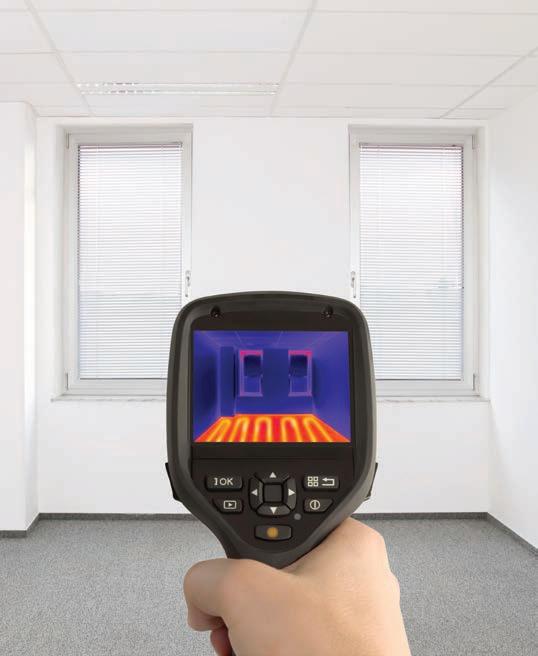
2. Aerial Drones
Drones have revolutionized various industries, and home inspections are no exception. With the help of a drone equipped with a high-resolution camera, home inspectors can access hard-toreach areas like roofs, chimneys, gutters, and tall structures.
Drones provide an aerial view of the property and can spot damages, wear and tear, and potential safety hazards that aren’t visible at eye level. This technology enhances the inspection process and improves safety for inspectors by eliminating the need to access dangerous areas on foot. Drone footage also includes unique views and angles of the house and surrounding area that you wouldn’t otherwise see, making it a valuable tool for buyers and sellers.
Images from infrared cameras and drones in the inspection
Carla Heatherly is the Director of Communications and Web Services at HomeGauge. HomeGauge offers report writing software, business tools, and website and hosting solutions for any budget. HomeGauge empowers inspectors to focus on what they do best –providing high-quality inspections–while leaving the techy stuff to the nerds. Whether you’re a new inspector or an experienced professional, HomeGauge has the tools and services you need to grow your business and succeed in today’s competitive market.
report add more value for the client. Inspectors who invest in these tools can charge more for their inspections, recouping the initial equipment costs and increasing their earnings in the long run. Some inspectors even consider using a drone or thermal imaging camera as an add-on service to the traditional home inspection and charge a separate fee.
In today’s digital era, a modern website with business tools, like online payments and scheduling, is critical for the success of any business. As a service-based business, your website is a customer’s first impression of your company. Here’s why a current website is critical to stand out in your market:
A professional and user-friendly website helps build trust and credibility with potential clients. A well-designed, modern website highlights the inspector’s expertise and qualifications and showcases testimonials from satisfied customers. Visitors who are impressed with your website are more likely to hire you.
Online tools make it easy for clients to interact with you. With features like contact forms, online scheduling and agreements, payments, and report retrieval, you offer a seamless and convenient customer experience. If someone has to wait more than a few seconds for your site to load or can’t easily find what they need, including a clear idea of who you are, what you offer, and how to contact you, they’ll search for another company.
A modern website serves as a powerful marketing tool. Invest in professional search engine optimization (SEO) services and stay active on your social media channels to reach a broader audience and attract potential clients. Consistent branding across the website and other online platforms reinforces your company’s identity and professionalism.

Optimize your website for mobile devices since most people use smartphones and tablets to search for services online. A mobile-friendly website provides a better browsing experience, making it more likely for visitors to engage with your content and services effortlessly. If your site doesn’t display appropriately across all devices, you’re missing out on business from customers who don’t have the patience to explore a site that doesn’t properly load.
Google loves content and great user experience above all else. Because of this, it’s crucial to keep your website regularly updated with helpful articles to show that you care about your visitors. Publishing new content, like a monthly blog, encourages the search engines to crawl your website more often and helps with your search engine rankings (SERPs) over time.
page 12 8

A modern design is equally important, as technology and design preferences change quickly in the digital world. That cool new thing from three years ago may have only been a cool new thing for three months. If your website is two to three years old, it’s time to consider investing in a new one. A fresh website will not only be more secure and functional but also much friendlier for your users.
1.
Radon gas can be found in any house, new or old, and is a severe health risk. If you’re in an area known for high levels of radon, become certified by the National Radon Proficiency Program (NRPP) or the National Radon Safety Board (NRSB) and offer radon testing as an additional service. Identifying radon issues gives clients the information they need to make informed decisions and mitigate unsafe levels. Radon testing can be an add-on to a basic home inspection or a standalone service offered to existing homeowners.
Wood-Destroying Organisms (WDOs), like termites and woodboring beetles, can seriously damage a property’s structure. By offering WDO inspections alongside regular home inspections, inspectors can identify and address pest concerns promptly. This specialized ancillary service adds value to the inspection and helps clients safeguard their investments.
Energy efficiency is increasingly important for homeowners aiming to lower their environmental impact and utility expenses. Conducting energy audits as an add-on to inspections allows you to assess the property’s energy performance, identify areas of improvement, and recommend energy-efficient upgrades.
Offering energy audits positions you as an eco-conscious professional and attracts clients beyond homebuyers. Energy audits are a great source of supplemental income in the fall and winter when homeowners want to reduce their heating costs. They are also an excellent service to promote in the spring to help homeowners minimize cooling costs before summer.
In colder regions, offering winterization services as part of home inspection packages can be a profitable opportunity. Winterization involves preparing properties for freezing temperatures and enhancing energy efficiency during the colder months. Homeowners value this proactive approach to preparing the property for winter-related issues. By providing winterization services, you can cater to clients’ needs in cold climates and offer them peace of mind as they face the winter season.
A sewer scope inspection uses a special camera to thoroughly check sewer lines for plumbing problems, leaks, and blockages. This helps detect hidden problems, especially in older properties or those with a history of plumbing issues, providing clients with greater confidence and peace of mind before making a pur-
chase or conducting repairs. Also, a sewer scope inspection is non-invasive and can find problems without the inconvenience and expense of digging up a lawn.
These ancillary inspections ensure that the pool or spa and its components are safe and the equipment is running properly. Any potential hazards or faulty components are identified an documented in the inspection report, giving homeowners the information they need to prevent accidents. Providing pool and spa inspections as a standalone service or an add-on sets you apart from other inspectors and boosts your earnings, too! It’s a win-win for everyone involved.
Along with ancillary services, you can stand out from your competition by finding other ways to add value for your customers. One way is by offering an inspection guarantee, like HomeGauge Protect, which covers home issues for a period of time after your inspection, providing peace of mind and confidence to your customers.
Consider offering past customers a special rate for re-inspections on repair work done after the original inspection. Providing discounted rates for yearly or biennial home maintenance inspections is also an excellent idea. This helps homeowners stay informed about their property’s condition and plan for repairs before costly damage occurs.
Remember, not all of your business has to come from new customers. When you continue to support those you’ve worked with before, you’ll become their go-to person for future needs.
When the real estate market slows down, embrace opportunities to invest in your professional development. Attend workshops, conferences, seminars, and webinars to expand your knowledge and expertise. Complete specialized certifications in areas like radon testing or energy efficiency to establish yourself as an industry expert, giving you a competitive edge when business picks up.
Review and improve your inspection processes during slow times. Look for ways to streamline your business by updating report templates and exploring new tools and technologies. Most software companies offer training sessions, online classes, and tutorials on YouTube. Take full advantage of these resources to work smarter, not harder. If you’re in the market for new software, use this time to check out new platforms. A more efficient workflow enhances customer service and increases productivity.
Use downtime to boost your network and marketing endeavors.
14 8

Cultivate strong relationships with real estate agents, contractors, and other professionals. Set up key social media accounts to connect with the community and others in the industry. Consider hosting informative workshops or webinars to showcase your skills and services to agents, homebuyers, and homeowners.
The slow season is perfect for revamping your website to include those new tools and services you’re offering. If your current website feels outdated, lacks expected features, or doesn’t display well on tablets and mobile devices, now is the ideal time to build a brand-new one. By giving your website the attention it deserves now, you’ll set a great first impression once business picks up again!
While you’re at it, create a social media calendar to keep you on track and marketing your services effectively throughout the year. For example, you can plan to share content about radon in January for National Radon Action Month and wind mitigation during hurricane season. Also, consider seasonal promotions to accompany this content, like a discount on radon testing or a wind mitigation inspection. Planning a thoughtful marketing strategy when business is quiet sets the foundation for a consistent business flow when the busy season comes back around.
Offer a special deal on pre-listing inspections during the winter months, and share it on social media and with agents or other
folks who send you referrals. When sellers know about issues and have time to make repairs before listing, their homes will be in a better position to attract buyers when they hit the market.
Stay connected with past clients and agents through initiatives like email newsletters and holiday greetings. Consistent and helpful communication keeps your services fresh in their minds, increasing the likelihood of repeat business and referrals. You may even consider offering a discount to repeat buyers, sellers, and agents to foster loyalty.
As a home inspector, you want to offer the maximum value to your clients while streamlining your operations. By investing in specialized tools and offering additional services, you’ll provide exceptional home inspections, attract more clients, and increase your earnings. Ancillary services like radon testing, WDO inspections, energy audits, winterization, and sewer scope inspections benefit clients and open new revenue streams.
During the slow season, focus on professional growth, optimizing your business processes, and improving your online presence to stay ahead in the market. Through innovation and diversification, you’ll thrive in the competitive world of home inspections while providing top-notch services to homeowners and buyers. WRE


Inspecting an attic is always a challenge because of limited access, temperature, and safety—BUT attics are a very important part of a thorough inspection and report. We need to inspect insulation, vapor barriers, ventilation, bath and kitchen venting, and the structure of the underside of the roof. What are some common and serious defects? How did they occur?
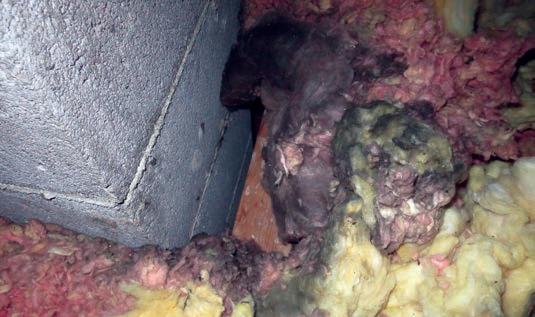
We have all inspected attics and noticed large gaps in the insulation covering the ceiling of the living space. Or maybe they were just small areas of uneven insulation. We make a note in our inspection report about gaps in insulation, but never how they got there.
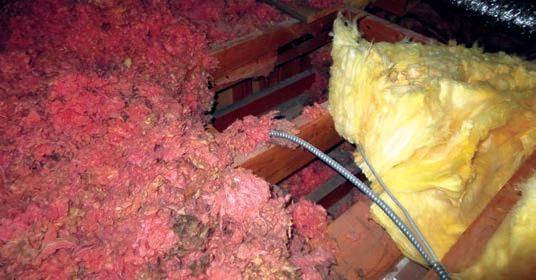
Many homes are constructed with dropped soffits over the kitchen and bath. These dropped soffits fill in gaps above cabinets.
At some point, an insulation contractor or carpenter spread a plastic Visqueen vapor barrier over the rough framing on the underside of the ceiling and inside exterior walls to stop airflow from the heated space. As they covered the ceiling, that dropped soffit framing was in the way. So, what did they do? Just skip it? (See Figure 1: Heat and Bypass at Soffit).
It’s very common to see this faulty installation: the dropped soffit is not blocked at the attic floor and not covered by the vapor barrier. These gaps in attic insulation and the vapor barrier create a huge potential problem—heated air and moisture will pour into the attic. The moisture will result in condensation on the cold roof structure then rot and mold (See Figure 2: Insulation at Dropped Soffit).
When you notice gaps or disturbances in the insulation, lack of blocking to support the insulation, or lack of a continuous vapor barrier, check the roof sheathing for signs of condensation and moisture. Look at the insulation for black stains that result from filtering dirt out of the air flow.
Air gaps are required at chimneys for fire safety, but as we tighten homes the large gap and air leaks can cause ice dams and attic moisture issues. Today when insulation is added to any attic, proper fire-resistant air sealing must be completed around all penetrations from the heated space, including the chimney. In Figure 3: Insulation Gap at Chimney, note the insulation and the black stains. The fiberglass insulation is a great dirt filter for the air flow from the basement to the attic. Talk about stack pressure!
In older construction, upper attic vents, can vents, static vents and box vents are placed high, near the ridge of the roof. Lately, these have been replaced with a continuous ridge vent: an
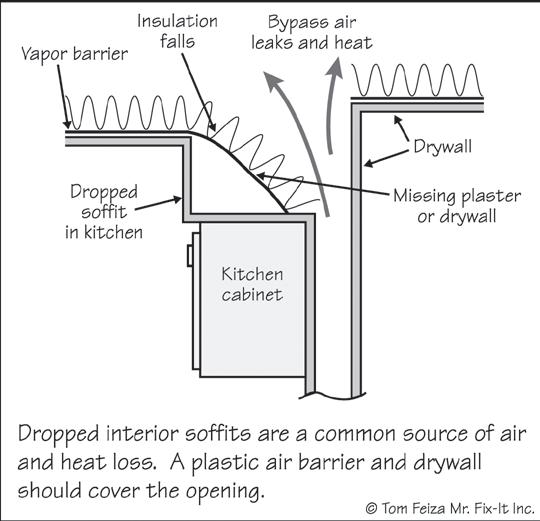
opening in the ridge of the roof covered with a mesh or plastic frame and shingles (See Figure 4: Attic Ventilation—Ridge Vent).

In static vent systems, wind or rising heat in the attic pushes air from lower vents to upper vents—removing heat and moisture. This worked well with simple roof designs. Older homes often had gable end vents, too, which worked in combination with soffit vents.
As homes were built with more complicated roof designs and tight envelopes that traps moisture, attic ventilation became an issue. The need to “cool” the attic to supplement air conditioning also became a concern. Solution: the powered attic ventilator! A fan that sucks air from the attic (See Figure 5: Attic Ventilation Fan). The fan control responds to high levels of heat and may include humidity control.
This is a great solution, but most of these fans were installed wrong. (See Figure 6: Attic Ventilation Fan—Installation Problem, pg. 18). When a powered attic ventilator is installed, all the upper vents in a roof must be closed. Yes, all the upper vents including a ridge vent must be closed! The fan pictured below (See Figure 7: Attic Fan with Ridge Vent, pg. 18) sucks air only from the adjacent ridge vent opening, which means the attic still is not ventilated.

Whenever a home has roof vents or gable end vents, they also must be closed to allow an attic fan to vent an attic properly. A lower vent at the overhang will enable complete ventilation.
 Figure 4: Attic Ventilation—Ridge Vent
Figure 5: Attic Ventilation Fan page 18 8
Figure 4: Attic Ventilation—Ridge Vent
Figure 5: Attic Ventilation Fan page 18 8
7page 17
At one time, a roof deck was one by six or wider dimensional lumber or plywood with dimensional lumber roof joists. Today, OSB (oriented strand board) is king: virtually all new roof decks are made of OSB on a structural roof truss. OSB is a proven product if installed correctly. Nailing, spacing, clips and spans are all important.
During a visual inspection, we really can’t see fasteners, edge joints and thickness, but we can see the width of the OSB spanning between rafters or roof joists (See Figure 8: Attic Thin Strips of OSB at Ridge Vent). Can you tell whether this narrow strip is properly installed near the ridge of this roof? The OSB has not collapsed or shown obvious signs of failure.
Clips between sheets are installed on only one side of the ridge. What is the required minimum width when we span 24 inches between roof trusses? Installing thin strips of OSB between roof trusses 24 inches on the center just doesn’t seem right.
Here’s a more obvious problem (See Figure 9: Attic Failed OSB at Ridge). In this case, the thin strips are about the same width—four inches. The strips, which span 24 inches, are collapsed, bulging and twisting. I don’t see any clips between the sheets of OSB.
In another case, the OSB strips are a little wider—maybe six inches (See Figure 10: Attic Thin Strips of OSB at Ridge Vent). A two-and-a-half-inch wide gap was cut for the ridge vent. The clips are also visible. Is this OK?
I spent some time checking design standards for OSB roof decks, and I quizzed several wood engineering scientists. I learned that the general standard for OSB roof decking requires a minimum width of 24 inches. This assumes that a roof truss system has the typical 24-inch spacing between trusses and a typical OSB thickness. If the panel width is less than 24 inches, panel clips or lumber blocking is suggested.
If the width is less than 12 inches, special blocking and support for both edges is required. When installed at a ridge vent, one edge must be supported by blocking.

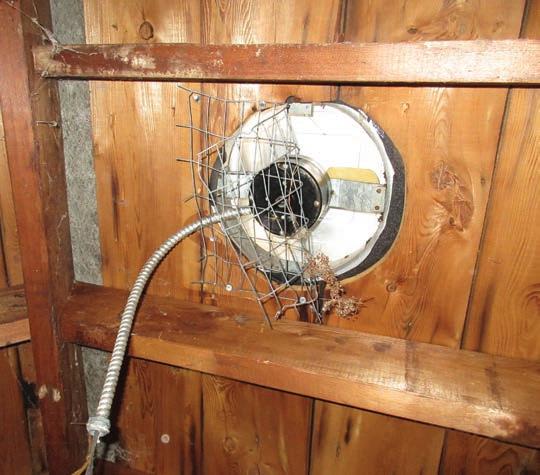
The wood structure and framing below the roof should be free of excessive stains, rusty nails, mold, rot and movement. Trusses and joists should be in alignment without cracks, excessive sagging or movement. You don’t need to walk in an attic without a floor and many times you can see issues from the attic hatch. When I see an issue from the hatch, I often enter the attic for a closer look if safe access is possible.

When peering into an attic, keep in mind that gaps in the
insulation could indicate the existence of a dropped soffit or a stairway. Watch for moisture issues. Make a report notation for gaps in the insulation, and the vapor barrier. Check for proper air sealing at the chimney, plumbing and electrical penetrations if they are visible. And if you ever walk/crawl around an attic, remember: gaps can be quite large, and there may be no framing to support you in areas hidden by the insulation.
During your inspection of the attic, always note excessive stains, organic growth, improper bath and kitchen fan venting, delaminating plywood, thin strips of OSB, excessive nail rust, and improper attic venting. Look for blocked vents or an inadequate number of vents.

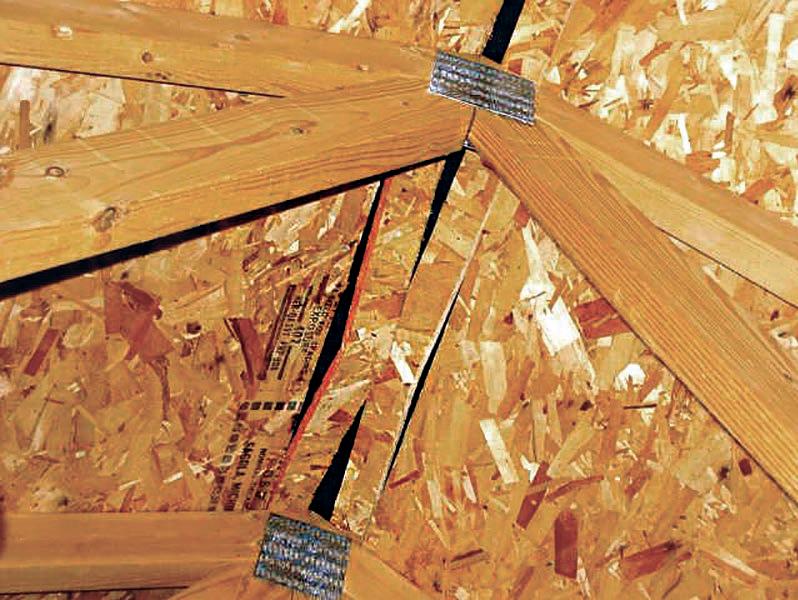
Any visible failures need to be identified in your report: failed OSB, rot, missing insulation, structural failure and movement, and all roof deck issues.
An accumulation of questionable items such as minor stains, lack of insulation, poor air sealing, and lack of a continuous
vapor barrier should be evaluated by an expert. If you recommend additional or improved insulation to meet industry standards, ALWAYS recommend evaluating and improving the air sealing. Air sealing is often neglected even when additional insulation is installed by the low bid “blow and go” insulation contractor. Air sealing was never considered in construction prior to 1980. Now with our tighter, more efficient “wet” homes, air sealing is essential.
If you have no or limited access into the attic, carefully document the limited access and the reason for the limited access. Access may be limited by no access panel or an access panel that is caulked shut or hidden by storage in a closet. Never skip the attic inspection—you may be the only person looking in that hot, unfriendly attic in the last 20 years. WRE
Tom Feiza has been a professional home inspector since 1992 and has a degree in engineering. Through HowToOperateYourHome.com, he provides high-quality marketing materials, books for homeowners, and illustrations that help professional home inspectors educate their customers. Copyright © 2023 by Tom Feiza, Mr. Fix-It, Inc. Reproduced with permission.
Visit HowToOperateYourHome.com (or visit htoyh.com) for more information about building science, books, articles, marketing, and illustrations for home inspectors. Contact Tom Feiza with questions and comments by email at (Tom@htoyh.com), or by phone (262) 303-4884.

Not only did the COVID-19 pandemic and work from home arrangements create health risks for home inspectors, it also may have exposed homeowners to additional unhealthy radon levels in their homes. Office buildings, hospitals, restaurants, and other public places often have advanced ventilation systems and indoor air quality protocols to protect the air people breathe. These same ventilation systems that focus on indoor air quality are not as prevalent in private residences.
An ongoing research study from the University of Calgary reveals that people spent more of their year in their primary residence after the COVID pandemic onset, which caused them to experience a 19.2 percent increase in radon exposure. In over 4,000 Canadian homes it was discovered the time spent within the home during the pandemic increased from 66.4 percent to 77 percent, which equates to 1,062 hours or more during a year. View the study here: Bit.ly/time-in-residence.

Radon is a gas that forms when the uranium in the soil beneath a home decays into radioactive atoms and seeps into the home through cracks in the foundation, crawl spaces, and basements. It is considered a Group A carcinogen which means it is proven to cause cancer in humans. Spending more time in one’s home highlights the need for radon testing. Long-term exposure to radon especially causes a risk for developing lung cancer.
Radon has a 3.8-day half-life, which allows the gas to be trapped within indoor environments where it will decay into Polonium 218 and 214. When inhaled into the lungs, these radon decay products with shorter half-lives can decay into radioactive alpha particles that damage the DNA of cells lining the lungs. These cell changes are called mutations. When cells have too many mutations they can stop working correctly, grow uncontrollably, and become cancerous. Radon is the leading cause of lung cancer after smoking and is responsible for over 21,000 deaths per year in the United States.
Children and young adults also spent more time within their homes during the pandemic. Social and extracurricular activities were canceled while schools and universities transitioned to remote classes. Educational settings have continued offering remote classes which further increases the time students spend inside their homes. This causes children and young adults to experience increased radon exposure at younger ages which can lead to lung cancer earlier in life.
Children have smaller lungs and faster breathing rates than adults, meaning they can inhale more radon gas. Children also have growing tissue and smaller bodies which makes them more affected by the radioactive radon they breathe in their homes. The “risk of lung cancer in children from exposure to radon may be almost twice as high as the risk to adults exposed to the same amount of radon,” the CDC Agency for Toxic Substances and Disease Registry states.
The rise of energy-efficient and environmentally friendly homes contributes to increased home radon levels. The research titled “Radon Exposure is Rising Steadily Within the Modern North American Residential Environment and is Increasingly Uniform Across Seasons,” published in Nature’s Scientific Reports found a 31.5 percent increase in radon levels in homes built after 1992 compared to older houses ( Bit.ly/radon-exposure-rising). Modern houses are too efficient at limiting the amount of unregulated air coming in or out. Therefore, new homes in North America contain greater and greater radon levels.
Designed to be airtight, newer houses are designed to keep cool air inside during the hot summer months and then heat inside during the cold winter months. While doing so, newer houses are also trapping more radon within homes.
Zan Jones is the Vice President of Sales and Marketing for Radonova, Inc. in North America. As the global leader in radon measurement, Radonova has performed millions of radon measurements in over 50 countries around the world. Contact Zan about passive radon detectors, commercial radon instruments, or personal radon dosimeters via email at Zan.Jones@ Radonova.com or call (331) 814-2200. page 22
A home inspection may be the only time a home is tested for radon. The EPA recommends that homeowners test their homes for radon every two years. It is also recommended that homes be tested for radon after a major renovation, during

Somebody always wants to blame the home inspector. That’s why you need a team with deep expertise who have been defending inspectors for decades.
OREP Members enjoy PROFESSIONAL pre-claims assistance with trial attorney Geoff Binney, one of the nation’s most experienced home inspector attorneys. Binney writes decisive response letters to shut down frivolous claims.
Trusted by over 12,000 Real Estate Professionals. Our business is defending you and your livelihood.
years
(888) 347-5273
OREP.org/inspectors

alternate seasons, if residents begin occupying a lower level of the home (like the basement), and after installing a radon mitigation system.
However, a study published in Nature Portfolio analyzed how radon exposure disparities are driven by psychological and social factors—such as average time from awareness to receiving a radon test outcome, how quickly high radon levels were mitigated, and how delaying behaviors increased lifetime risks of lung cancer by as much as 30-40 percent. A striking observation was that almost half of the people who had “low” or “safe” radon levels stated they had no intention to test for radon again in the future. This highlights the importance of having accurate radon testing during a home inspection. A false negative outcome could increase lung cancer risks over a lifetime for those who decide not to test again. See the study here: Bit.ly/radon-exposure-disparity
As a result of the COVID pandemic, working from home and/ or hybrid telecommuting has transformed from an emergency response to a situation that is here to stay. Working from home presents higher radon exposure risks that need to be considered by employers and employees alike. Energy-efficient homes save homeowners on their electric bills but can increase the radon exposure for those working from home or remaining home during school hours for remote education.
Employers have a responsibility to ensure the indoor environment where their employees work is safe. In the future, this responsibility could be applied to employees’ homes for workers required to work from home. If not, there may be a rise in lung cancer cases, especially impacting the younger generation.
Home inspections are even more critical at a time when homebuyers are opting out because of the housing demand. A home radon test can be provided by a certified professional or completed using a simple home test. If radon levels are above the actionable limit of 4.0 pCi/L then a radon mitigation system should be installed in the home by a certified professional to lower the radon levels. Here are some notable Radon stats:
• 1 in 15 homes in the United States have high radon levels
• 21,000 in the United States die from radon induced lung cancer every year
• 230,000 people worldwide lose their life to radon induced lung cancer every year
• Radon exposure at the actionable limit is equivalent to getting 200 chest x-rays per year or smoking 7-8 cigarettes per day
Radonova is the laboratory of choice for numerous public and private sector large-scale radon measurement projects around the world. A truly global laboratory, Radonova is active in over 50 countries and has performed millions of measurements. WRE



I n roof framing, it is widely understood areas of most interruption, or planar differences, pose the greatest risk for leaking (think valley, or greedy dormer). Ergo, the more complicated a home’s roof line, the greater risk for leaking. How do professionals manage this? Flashing.

Now, let’s move that concept down from the roof to the wall assembly. If you have a wall made of wood, that wooden wall will inevitably end. In our region of middle Tennessee, it usually ends on the foundation (concrete blocks aka CMUs), but slabs are becoming more prevalent and we do have old housing stock (stone and brick foundations).
Where that wooden wall ends (you have to picture the wall naked of siding/cladding) the materials are dissimilar (usually wood and concrete or masonry). Dissimilarity, in home performance, is the ideal location for issues to develop—usually via air, moisture, and pest. The solution would be, like roofing, flashing. The problem is flashing of wall assemblies and components is not a highly regulated area of home production in our region and, based on what I see often, there is a wide spectrum of understanding and skill by those performing the work.
Oftentimes, wall flashing is overlooked, or under-executed. In some of our housing stock, the home survives with deficient wall flashing purely because the interior enclosure is very much perforated (not air-tight) and the walls can dry. But what happens in our younger homes?
This home in particular was built in the mid-2000s and likely was intended to be a moderate-to-high-end home based on materials used and aesthetic finishes. Composite cement fiber product was used for siding. Concrete cast stone veneer (“lick and stick” as it is so lovingly referred to here) was used for both foundation veneer AND some areas of siding. Where the cement boarding terminated and adjoined the stone ven-
eer, there sat a shelf. A very flat, flat, shelf (See Figure 1: Shelf Between Cement Siding and Stone Veneer).

As best I could tell, there was no flashing beyond a typical weather-resistive barrier installed along this common joint line (which ran around the entire perimeter). The concrete cast stone veneer appeared to be adhered via thin-set directly to the wall assembly over the Weather-Resistant Barrier (WRB) with no adequate separation and this negates any water management ability…but, I digress.
Our flat joint had no special flashing installed. Flat surfaces hold water, or at least don’t let it drain away and off. When water is held flat, it will follow capillarity (think trees) and find other points by which to travel—up, down, sideways. At our dissimilar joint with no special flashing, the water readily accessed a percentage of the walling assembly over time. Time and moisture vs. (Oriented Strand Board) OSB. Which do you think wins? Hint: pick moisture.
This 20-year-old home was set up for disaster at the onset of construction. With no attention to flashing detail, and no apparent understanding of needing to protect engineered laminated products (OSB, manufactured I-joists which were the substructure framing), this home started rotting very soon after construction. And unlike old draftier housing stock, this home was less drafty (still drafty, just less drafty). Less drafty means less drying or longer drying time. Prolonged exposure to moisture delaminated the resins/adhesives in the engineered materials, primed the wooden fibers for pest snacking, and degraded the general strength of the framing.
By the time I came on the scene, the damage had already been done. The un-flashed joint work at the exterior was my first clue. My knowledge of the abhorrent installation practices of concrete cast stone veneer in my Tennessee market was my second. A very pervasive and present musty odor in the garage was my third (have we talked about garages not being air tight and communicating air with crawlspace and interior space?!?). My fourth and final clue was the degrading or already deteriorated rim joist, I-joist ends, and sill plates
around the perimeter of the structure. Only along the perimeter of the structure in these areas.
Figure 3, pg. 26 shows late-stage degradation to rim joist, sub floor, and supporting framing—all due to no proper flashing.
Wood is comprised of polymers (like most things, glucose is the King at the molecular level for form and energy). Some of those polymers form cellulose and lignin, the two components that help wood in its natural form, withstand biodegradation for an extended period in the natural world. However, we’re talking about processed wood here and wood that has had the moisture removed as part of the engineering process. If you remove the water in the wood fibers, the degradation slows down even more. What happens if/when you reintroduce continued cycling of wetting to those same wooden fibers that were mechanically dried out? You are correct if you said it speeds up the microbes that “eat” the wood. Additionally, we get oxidation of the wood fibers which lends to the very darkening of wood coloring. Oxidation also is a decay process. (See this 2011 MIT paper for a brief explanation of wood and moisture: Bit.ly/wood-and-moisture.) page 26 8



Let’s jump ship from chemistry. I usually don’t bring up science with clients or in field reports because it’s confusing and usually unnecessary. And in truth, I usually have to “refresh” my own understanding routinely. The simple explanation fits well—you can’t take a material that was intended to be dry post-processing and allow it to repeatedly get wet. It degrades and anything it was supporting it no longer supports as well. Ergo, you must protect this dry product and keep it dry. Dry from the exterior wet world and dry from the interior (crawlspace) wet world. When you fail at this, the material(s) fail and you get unhappy homeowners, or shocked buyers who no longer want the otherwise pretty home. Pardon my artistic skills, or lack thereof, in Figure 4: Flashing Illustration. Here we see a crude mock-up of what flashing should “look” like where the walling meets our foundation, or at similar dissimilar junction points.

All of this, and I mean all of it, could have been avoided by a well-executed flashing installation. Then again, you can’t execute flashing installation well if the installer doesn’t understand the basic principles of building science and why they should flash, where they should flash, and how the flashing should be designed (ahem, to shed water…). It’s important for inspectors to be aware of these type of incidents, so they can help homeowners identify them as quickly as possible. WRE
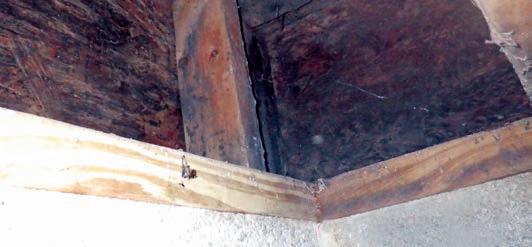

It is no secret that in the home inspection industry there aren’t many Black, Indigenous, or People of Color (BIPOC) individuals, nor are there many women. In a landscape where diversity and representation are still making strides, Harmony Brown, a remarkable woman of color, the visionary CEO behind GreenWorks Inspections & Engineering, stands as a shining example of resilience and achievement who has broken through barriers with unwavering determination—a true success story.

Always striving toward innovation and excellent service, GreenWorks Inspections & Engineering has carved a distinguished niche across Texas, spanning more than 45 cities and conducting over 18,000 inspections annually. Renowned for their pioneering spirit, the company’s portfolio encompasses comprehensive structural engineering services, with an impressive collective of experts on-staff, including Structural Engineers, Engineers in Training, and Drafters.
As evidenced by her company’s five-star reviews, Brown’s journey stands as a testament against adversity, bolstering her GreenWorks legacy for an impressive thirteen years.
In an interview with Harmony Brown, we delved a little deeper into her motivations. Here’s what she told us:
Brown: My journey into home inspections was accidental. I was in college—22 years old, in my fifth year of school. I was lost, bouncing from place to place and struggling to find a major that I could truly enjoy. I knew it was possible—that I could find something where I could be both happy and successful.

I found a course on Google that basically said, “Hey, here’s the way to find your passion!” I went through this course, and it turns out I’m incredibly passionate about houses and real estate (and I love watching HGTV). The course was designed to help me find the things that I most liked and enjoyed. That led me to real estate school, which led me to a lot more research.
I spent a lot of time picking up the phone, calling appraisers and asking them what they did. Then I called the mortgage brokers, and the real estate agents, and so on. I found different reasons for why each of them wasn’t a great fit for me, but then I got to the home inspectors and I asked what they did for a living. Their days consisted of going out, meeting Realtors®, trying to build a business and if they were lucky, they got to do inspections for half the day. They had to build a pipeline of marketing in order to get those sales. I listened to their whole spiel, and I asked, “Do you guys enjoy doing this?” And they said, “No, I hate it.” That’s when I knew, “That’s it! That’s what I can do!” The realization struck me like a lightning bolt. I was certain I could get work for these guys.
I began walking down that path: going out and trying to get that work. Starting out, I was terrible at it. I had the drive and the will, but it took me a very long time to figure out the process. I had no money, no connections, and no real skill. However, it was something that I wanted to do so I kept at it. Sixteen months later, I finally got my first customer. Once I hit that milestone, I had to grind another four months to get my second one. I was working at it full-time, and it was a huge challenge, but I didn’t give up! I knew it was something I could figure out if I just kept going. Luckily, that second customer was very satisfied and told other people about me, which led to more customers, and I just kind of built my business slowly. One customer a week led to one a day; one a day led to one an hour, and now we are one of the top two largest privately-owned inspection companies in the nation! We’ve been doing it for 13 years and I’m always looking forward to growing and doing more.
Question: What inspired you to start your own company? Can you tell me a little bit about GreenWorks?
Brown: I wasn’t really looking to start a business per se. I was looking to find a place where I could add value and make a difference. I couldn’t find anyone who saw my potential and was willing to take a chance on me. GreenWorks’ entire business in the beginning was just me trying to connect home inspectors to clients, and back in 2009 that was a very difficult thing to do.
Today, we have a full suite of services—we offer just about any page 30


service you might think of relating to home inspections. We can service most needs in the commercial realm as well—multifamily properties and skyscrapers to small warehouses and everything in between. Our environmental consulting department has been very successful; we don’t do any remediation, but we do all the testing and consulting for lead paint, asbestos, and mold. Our structural engineering department has grown exponentially, and the services they offer include any sort of plans or design work that someone may need for renovations or new construction. Those, along with residential and commercial property inspections, are our main areas of focus, though we are always brainstorming for services that will add value for our clients.
Question: Are there any challenges you have faced as a BIPOC woman when you first started in this industry or even today?
Brown: Absolutely. I think there’s always a feeling like you need to prove yourself. You need to go above and beyond. I think that some people really excel at that. They come into it with a great mindset of, “I’m willing to do more to prove that I’m the best because I know it’ll help me become the best.” That’s the kind of attitude that I’ve always had, even though it can be frustrating to feel like you have to do twice as much. You have to build a team, build culture, and convince clients that you’ve got the absolute best service for them—and not looking like everyone else does make a difference. I just embrace standing out and providing great value.
It hasn’t always been easy getting work as a person of color. I mean, no one was openly saying “I’m not going to work with you for this reason,” but some of the people I met didn’t have to say it, I just knew why. But I always tell myself, “Well, I’ll just keep doing a great job and eventually, you’ll hear about us and we’re not going anywhere. We’re going to stay around and we’re going to keep doing our thing.” And here we are.
We’ve got nearly 30 inspectors within the Dallas/Fort Worth area. Our team boasts 60 inspectors across the state and 13 skilled engineers. In total, we’re proud to have 85 dedicated field members, which includes our engineering and environmental technicians. Our company has a total workforce of 119 team members, and we’re supported by a fantastic network of partners who add value to every transaction.
Our aim is for every home inspector in Texas to be familiar with GreenWorks. Most Texas inspectors have at least heard of us within three years of launching their career—an achievement we take great pride in. Our grand ambition is to serve millions of homes across the nation. Currently, we cover the entire state of Texas and we’re going to continue to grow our capabilities and eventually extend our services beyond Texas when the opportunity arises. It’s really about having that mindset, leading with integrity, and being willing to work harder than others to get ahead. When you do the work, you reap the benefits of it.
Question: There are not many BIPOC individuals or women in the home inspection industry nowadays. Why do you think that is?

Brown: I think people tend to get drawn to industries and businesses where they see people that look like themselves. Positions in the home inspection industry are predominantly occupied by white men, which might discourage diverse people from entering the field. I also think there’s a lack of understanding of how many different types of opportunities exist in the home services industry, because the home services field is often perceived as a self-starter business, which can be intimidating.
I’m really proud of my achievements and the incredible team that has come together over the years. There’s no question: I could never have done any of this without them. We encourage each other. We challenge each other. We cheer on all the innovators in our company striving to build something really special together—that’s what has led us to this level of success. With what we’ve achieved, I hope others can look to my example and know that there are opportunities for them in this field. Over the 13 years I’ve been in the industry, I’m proud to say I see it becoming increasingly diverse and inclusive.
Question: Do you have any advice for those who want to get started in home inspecting?
Brown: Call us! There are different ways to get into home inspections or even the home service industry in general. We are open to hiring people with zero experience who are interested in getting into the business. We can help you build your career from the ground up and show you how to get started so you can go to school, earn credits, do the schooling
while working with us, and see if it’s a good fit. We have a lot of friends in the industry, plus we have an abundance mindset. We’re trying to help the industry grow and thrive and succeed.
Becoming a home inspector can be difficult due to the cost of schooling, which can cost up to $3,000. Not everybody has that kind of money or time to invest, but if you can be working for a company in the career that you want while going to school then it can be an amazing opportunity. We take pride in being able to offer that. We can lead you to the right path and help you pick a good school with great instructors.
Question: Is there anything else you would like our readers to know?

Brown: If you’re interested in the field of real estate, the best thing you can do in my opinion is to actually talk to the people who do the job. Talk to as many people as you can. Ask questions. I think it’s important and helpful in the decision-making process. We will be completely honest with you about what it is like to work as a home inspector, so you can make an informed decision whether that’s the path you want to go down.
There’s a lot to consider; if you want to get involved it’s going to be an investment like any great career. It is an awesome
career though! If you love it, and you love houses, and you love people, then you can definitely succeed.
If you are looking to join a team that really pushes you to succeed, check us out at GreenWorksInspections.com. We guarantee our inspectors a minimum of four to five home inspections per week, offer a wide range of benefits, a flexible schedule, and we are always growing! WRE
D oes a home basement need a second “code legal” exit to prevent future injuries or deaths to the occupants, AKA, your clients?
Today, the answer is almost always yes—the basement does need a second exit. The only exception, per the 2020 ICC Residential Code in 48 states, is when the basement has only, a work area, laundry, storage, heating areas and has no habitable rooms.
What is a habitable room? The 2020 ICC Residential Code defines it as but is not limited to living rooms, dens, bedrooms, playrooms, kitchens, family rooms, etc. So, when real estate salesmen say you need only need be concerned with bedrooms—don’t listen. Bedrooms are only one type of habitable room, and all habitable rooms in a basement need a second exit.
I will often visit a home and see a rug, toys and a children’s bookcase in a section of the basement—a playroom, a habitable room and yes, even children need protection from death and injuries. Per code, if you have “habitable rooms” like a playroom, bedrooms, dens etc. you need two legal exits, period.
This is important for a multitude of reasons. For example, when there is a fire, a fireman’s first job is to get all the people outside of the home before putting the fire out. Now, picture the one wooden basement stairway is on fire, and there are no other exits, causing insurmountable problems for the firemen. It might at this point not even be possible to go down to the basement, get the people outside, resulting in deaths or injuries to the home occupants.
The most common legal second exit homeowners add is a new large outside factory-built window well. Most usually add two; only one is needed unless the basement is large. In addition to saving lives, the large outside window well provides a lot of sunlight into the basement. This is often

Charles
mentioned by owners after the installation, and I have seen a really great improvement in the quality of basements with this feature. Another advantage is that most of the installation is done on the outside of the home rather than inside it.
For escape purposes, the bottom of the window well must be no more than 44 inches from the basement floor and has a built-in ladder. Additionally, it must have a metal grate on the outside that can only be operated from the inside, in order to prevent burglary. Don’t worry, this will only stop a fireman for a moment—they have the right equipment for getting in. For rain and snow, a clear plastic cover is available on the top outside of the new window well. Since you are removing a section of the basement wall, for structural reasons, a new beam across the top of the opening, supported at both ends by the remaining basement wall is necessary. If the new exit is in a habitable room, it cannot be locked or that would prevent access from other basement habitable rooms, like the kid’s playroom.
Another second exit allowed is the “bilco” outside the stairway. This consists of a sloped cover, usually made of wood, that provides a second legal exit. The top opening doors can be locked from only the inside allowing escape without a key. If you add it, all work is on the outside of the home. If there is no door at the bottom and you add a door a new beam across the top of the door opening, supported at both ends by the remaining basement wall is necessary. The stairway can be a
page 34 8

concrete prebuilt you can purchase and install after removing the ground.
A third option is a second basement stairway that is fully open, with an attractive basement door, that has glass for light in the basement. This will also need a new beam added across the top of the door opening. The advantage is this stairway is better looking than a bilco stairway and can have an attractive outdoor light above.
A fourth is a second stairway to the first floor, which can be a spiral staircase, often at the other end of a first-floor hallway. Spiral stairways are permitted for interior use as means of egress from a habitable room, a basement, or from an attic, provided the minimum width shall be 26 inches with each tread having a 7.5 inches minimum tread depth at 12 inches from the narrower edge. All treads shall be identical, and the rise shall be no more than nine and a half inches. A minimum headroom of six feet and six inches also must be provided. However, a spiral staircase is not permitted to be the only means of egress from a story of a building.
Now, another important inspection rule: life safety for indoor basement stairways. Can a child fall between the steps by the basement stairway not following the four-inch rule? Four
inches is the size of a small child’s skull, based on tests following accidents.
So, based on the number of death or injuries, the ICC changed to the four-inch rule up to 44 high on all sides of basement stairways and landings a few years ago. Many small children have fallen off the stairway and landed headfirst on the concrete floor which is why the ICC Residential Code changed.
In conclusion, here are important factors to remember from the ICC Residential Code:
• Add a ¾ inch of plywood on the back side of stairways.
• Are both sides 44 inches with no four-inch gap anywhere in between, including at any landing?

• Landing is 30x30 inches, with no angle steps, and head clearance is at least six feet and eight inches.
• Stairways shall not be less than 36 inches, in clear width at all points above the permitted handrail height and below the required headroom height.
• Handrails and the minimum clear width of the stairway at and below the handrail height, including treads and landings, shall not be less than 31.5 inches where a handrail is installed on one side and 27 inches where handrails are provided on both sides. WRE

Home inspections are not ‘Code’ inspections, and a lot of home inspectors react to the word “Code” as if it’s taboo. Some even call it the ‘C-word’. In this article, I’ll share the arguments that home inspectors make against inspecting To Code, and then share my two cents on the subject.
There are two large national organizations for home inspectors in the United States: The American Society of Home Inspectors (ASHI), and the International Association of Certified Home Inspectors (InterNACHI). Both organizations make it clear in their Standard of Practice that home inspectors are not required to report on code compliance. The ASHI Standard of Practice states that “Inspectors are NOT required to determine compliance of systems and components with past and present requirements and guidelines (codes, regulations, laws, ordinances, specifications, installation and maintenance instructions, use and care guides, etc.)” While InterNACHI says, “The inspector is not required to determine compliance with codes or regulations.” If you look up the standard of practice for any licensed state, you will surely find a similar language.

Besides our standards of practice, home inspectors don’t inspect To Code because it’s just about impossible to do so. If a home was built To Code 50 years ago and nothing has changed, the home still meets code requirements. That’s the way building codes work. To inspect a home To Code, I’d need to be familiar with all of the historical codes for every trade, for every time period, for every house. Even here in the Twin Cities, where we’re all supposed to be on the same page when it comes to building codes, we still have inconsistent enforcement and interpretation of building codes. There’s no way that any person could possibly keep all of this straight.
Additionally, home inspectors are not code enforcement officials. We have no authority to make anyone do anything. What is the point in doing a code compliance inspection anyway? Building codes continually change to help make our buildings safer, more durable, and more energy-efficient. If I inspect a 50-year-old house that hasn’t had any changes made to it, and I only inspect To Code, I won’t have much to say. But because I’m doing a home inspection, I’ll surely have many recommendations to make regarding safety, durability, and efficiency.
Reuben Saltzman is a second-generation home inspector with a passion for his work. He grew up remodeling homes and learning about carpentry since he was old enough to hold a hammer. He worked for Structure Tech since it was purchased in 1997 and is now the owner and CEO of the company. To connect with him, visit https://structuretech.com/

None of my recommendations have any “teeth” as I can’t make anyone do anything, but my client will have a far better understanding of what they’re buying.
Home inspections are conducted to educate the client, usually a home buyer. The ASHI Standard of Practice states that inspectors are required to report on unsafe conditions, which is defined as a condition that is judged to be a significant risk to bodily injury during normal, day-to-day use; the risk may be due to damage, deterioration, improper installation, or a change in accepted residential construction standards . So, what are these standards? This is not explicitly defined, but home inspectors all know that this means ‘building codes’. This is how construction standards are defined.
Inspectors in different parts of the country have different building codes and different construction standards. What is acceptable in one part of the country might be unacceptable in another, and vice versa. Home inspectors should be expected to know what is acceptable in their state or city and be able to prove it if necessary. This means knowing the building codes for their area. Every home inspector ought to at least know what version of the building code is adopted in their area and be able to look up code references if something is questioned.
When I say building codes, I’m referring to construction, mechanical, plumbing, fuel gas, electrical, and energy codes. I include local amendments to these codes. Here in Minnesota (MN), we make a ton of changes to the International Residential Code, but no changes to the National Electric Code.
Deciding what to include in a home inspection report is always a balancing act for the home inspector, and there is no clear right and wrong way to do it. I use the building codes as my North Star, but I must rely on a solid understanding of the “why” behind building codes in order to make my recommendations.

7page 36
Let’s work through a few conditions that I’ve written about previously, and how I would choose to report on them.
GFCI devices are life-safety devices that prevent people from getting electrocuted, and they’re required all over the place today. When I inspect a home of any age that doesn’t have GFCI devices in places like the bathrooms, kitchen, garage, outdoors, and unfinished basement areas, I recommend adding GFCI protection for added safety.
100-year-old house with a steep basement stairway
Stairways are surely the most dangerous part of a house. Old, steep stairways are less safe than modern stairways. So, what do I say about an old, steep stairway? I might mention to my client that it’s less safe than a modern stairway, but that’s about all. There’s nothing that can practically be done about old stairways, other than adding handrails and guards if they’re not present.
An air admittance valve in place of a plumbing vent
Air admittance valves aren’t allowed here in MN, but I think they’re fine. Nevertheless, if my client decides to remodel their bathroom someday, their plumber will surely make a stink about this and say, “Your home inspector missed this.” For this reason, I would let my client know about this condition.
Here in Minnesota, soft copper is an acceptable material for gas piping. It meets code, and I would have nothing to say about it. On the other hand, if I were inspecting a home in another part of the country where soft copper wasn’t allowed, I’d be sure to include this in my inspection report. I’d tell my client that material isn’t allowed because it has a greater potential to be damaged. Does this mean I’m inspecting To Code? I don’t have an answer to that question.
Nothing in the building code says you need guards or fences near retaining walls to help prevent accidental falls, so what is the problem here? A small child could still be seriously injured or killed. I’d point out this potential safety issue to my client, and suggest they consider adding a fence or guard. I wouldn’t call this a defect, just an opportunity for added safety.
I could go on with examples, but I think I’ve made my point. There’s no black and white way for home inspectors to report, but I believe it’s important for home inspectors to be familiar with building codes, even if we’re not inspecting To Code. To hear a discussion from the viewpoint of both a building official and a home inspector, visit Bit.ly/structure-tech-podcast WRE


EXPANDED HOURS
8-8 EST (5-5 PST)
(888) 347-5273
LIVE CHAT at OREP.org

Broad coverage should never be optional, according to Isaac Peck, Senior Insurance Broker at OREP. “If you want to do the best for yourself, your family and your business, be sure to choose a professional insurance policy that will protect you adequately should the unexpected happen,” Peck says. “A broad policy covers you for the threats that you can anticipate as well as the unexpected ones that you don’t see coming. A broad policy covers all the bases and keeps you safe.” The OREP E&O insurance program includes Errors and Omissions, General Liability Coverage, Radon, Termite/WDI/WDO, Lead Paint, Pool & Spa, EIFS/Stucco, Indoor Air Quality Testing, Green Building Inspections, and Infrared Thermography. Prior Acts, multiple inspectors, commercial, additional insured for agents/referring parties and much more are included. Mold and septic are available. Please ask your OREP agent for details. All Members enjoy free claims assistance, risk
management and automatic membership in the OREP Professional Support Network ($59 value), which includes free, on-demand inspection support, savings on professional contracts, discounted state-approved education and training, Working RE magazine, discounts on office supplies, technology and more. Call (888) 347–5273 or visit us online at OREP.org. OREP Insurance Services, LLC. Calif. Lic. #0K99465.
OREP Members in CA enjoy access to Kaiser Permanente and Blue Anthem plans. The group plans provide benefits not available to individuals and at no extra cost. Those who purchase their medical coverage through the OREP group plan also enjoy a $10,000 life insurance policy included at no extra cost. The policy, written through Mutual of Omaha, is guaranteed-issued without any exclusion for medical conditions and pays double in the event of accidental death and dismemberment. Also included is the New Dental Choice Plan that gives you significant discounts of 15–60 percent for dental services. There is no cost above the medical plan itself for these services, including expert help navigating Covered California. If you are a CA resident/OREP Member email info@orep.org for information.
InspectorAdvisor.com is an ONLINE FORUM for home inspectors hosted by OREP, featuring veteran inspector and code guru Jerry Peck for answers.



